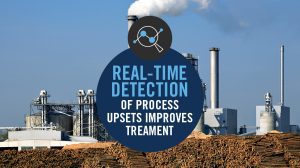 A pulp and paper mill in Louisiana, USA, was reliant on daily grab samples for detection of spill events which was found to be inadequate for proper management of the treatment processes. Real Tech proposed a customized solution that would allow the plant to monitor various parameters of concern in real time on the mill effluent.
A pulp and paper mill in Louisiana, USA, was reliant on daily grab samples for detection of spill events which was found to be inadequate for proper management of the treatment processes. Real Tech proposed a customized solution that would allow the plant to monitor various parameters of concern in real time on the mill effluent.
Background
The monitoring system was installed on the effluent of primary clarification. The solution included calibrations for BOD and black liquor, as well as other materials and compounds including white liquor, weak wash, soap, tall oil, turpentine, and foul condensate Real Tech’s most robust primary wastewater-grade system was selected for the site to cope with the harsh primary effluent wastewater conditions and Real Tech’s high-resolution UV-VIS PL-Series sensor was used to obtain the data needed for accurate and reliable parameter and contaminant calibrations.
The system continues to learn the mill’s effluent, adding more strength to the calibrations and confidence for the plant over time. As the mill experiences new events, event time and characteristics information is relayed to Real Tech. This information is then matched with the sensor’s real-time data and used for improving the event detection algorithms employed. Once installed and commissioned the system delivered continuous information to the mill on BOD and black liquor spill events, alarming when set concentrations are exceeded. By implementing real-time monitoring, the plant was able to see results in two key areas:
Recovery of Value Streams
Site specific thresholds for black liquor have been established and real-time information is relayed from the Real Tech system to a graph on the operator’s
screen. This allows staff to track and monitor effluent loading, alarming when problems arise, or upsets occur. Providing an early warning allows the operators to respond to events in a timely manner and reduce black liquor loss to drain.
Process Optimization
The real-time BOD information captured by the monitoring system is used to supplement data collected from DO probes in the aeration basins. This way the plant is able to confirm the required aeration rate from two independent sources, which increases the operator confidence. In addition, when high BOD loads are detected, upstream processes are investigated for potential upsets which expedites decision making for corrective action. The real-time BOD data is also used to aid in nutrient dosing optimization for an effective biological treatment in the aeration basins.
